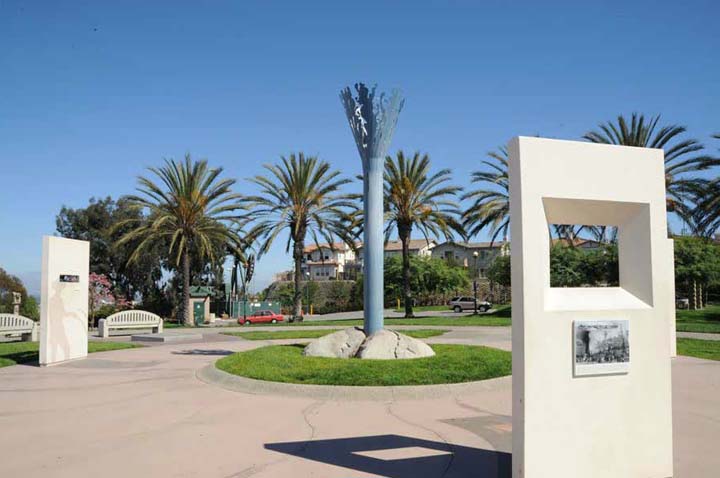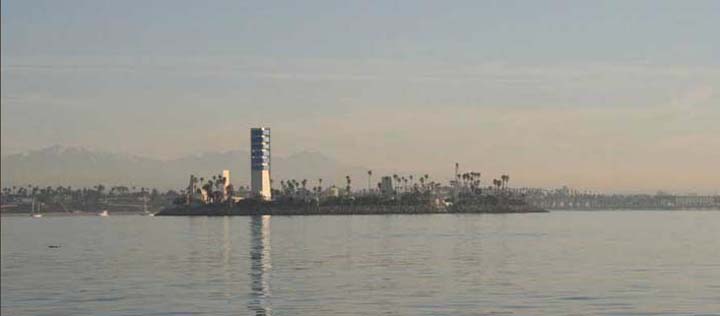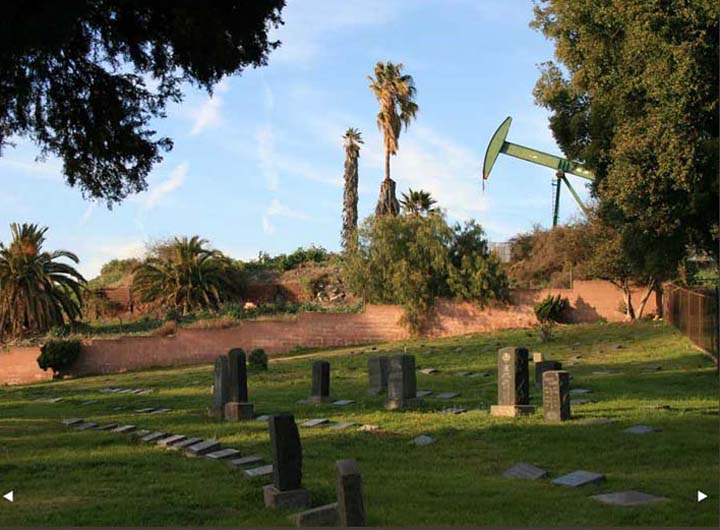Petrochemical Los Angeles
Editor’s note: This feature is extracted from Urban Crude: The Oil Fields of the Los Angeles Basin, an on-line exhibition at The Center for Land Use Interpretation and the third installment in CLUI’s exploration of the American “petroscape.”
The landscape of oil in the USA touches every state in one way or another. Los Angeles is unique, as in addition to being notorious as a city that grew up with and for cars, it continues to be an active oil field. The CLUI focused on this subject for the third installment of a trilogy of oil exhibits in 2009.

A 1923 view of Signal Hill, in Long Beach, Los Angeles. Courtesy the Library of Congress.
Los Angeles is the most urban oil field in the United States. Here, the petroleum industry operates in the cracks, corners, and edges, hidden behind fences, and camouflaged into architecture, literally pulling oil out from under the feet of the city’s inhabitants.
Every year around 28 million barrels of oil are extracted from 41 oil fields under the Los Angeles Basin. (An area defined as the urban region of Southern California south of the San Gabriel and Santa Monica Mountains, and north of the San Joaquin Hills in Orange County—what the state Division of Oil, Gas, and Geothermal Resources designates as District 1.) Twelve million of these 28 million barrels come from portions of oil fields that extend past the shore, where three offshore platforms and four artificial islands extract oil from beneath the land and the ocean. The rest of the oil extracted in the basin comes from fields that were initially developed between 1880 and 1943, and they underlie a quarter of the city’s urban land.

A park at the top of Signal Hill has interpretive panels that discuss momentous events in the area’s history, mounted on kiosks that frame important views.
In the mid 1920s, Los Angeles was the largest oil-exporting region in the world. At the peak of production in 1969, Los Angeles produced 133 million barrels of oil. Today, of the thousands of wells known to exist, around 5,000 are still in use. Though the fields are being depleted, it has been estimated that less than half of the recoverable oil in the Los Angeles basin has been removed. This is a calculation based on economics: the relative price of oil, and the cost of extraction. Los Angeles is an active laboratory for how to extract oil from a developed city, a phenomena that may become more significant as more of the world develops, and urbanizes.

The architectural features of Island White, off the coast of Long Beach were designed by Disney theme park designer Joseph Linesch. Owned by Thums Long Beach Company, they were built in 1964 by a group made up o Texaco, Humble Oil, Union, Mobil and Shells: THUMS, now owned by LA-based Occidental Petroleum.
Oil fields are not desired in most nonindustrial areas—they are generally considered unsightly, dirty, and smelly. Thus the oil industry has had to develop defenses against the rising value of land, and the encroachment of housing and retail. Sound muffling technology and visual barriers help shield the industry from the community.
While production continues in the cracks of the city, there are still several large swaths of exclusive oil production land that have remained in their pure industrial state, and are still used only as oil fields. These places are off limits to other forms of development. As land in Los Angeles increases in value, the pressure to convert the remains of these true “oil fields” into real estate will increase to the breaking point. The oil industry, though blamed for many urban woes, has paradoxically left a legacy of the largest remaining open spaces in the basin. How to develop these fields represents one of the major regional land use debates of the future.

From the Urban Crude slideshow.
View Urban Crude: The Oil Fields of the Los Angeles Basin in its entirety.


